by M. Roll and C.R. Wilson*(8/20)
Revised by L. Greene**
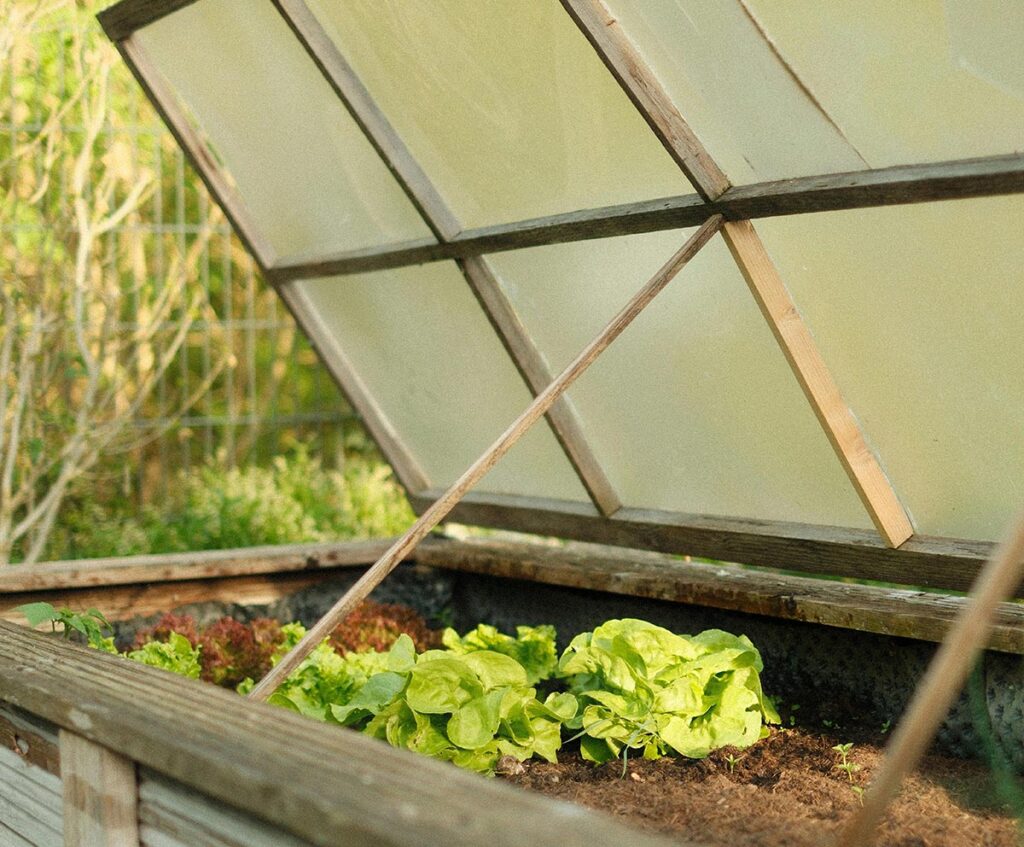
Quick Facts…
- An advantage of container gardening is its portability and suitability for many lifestyles.
- Container gardens allow creative expression in small spaces.
- Container gardens are excellent for beginners as well as advanced gardeners.
- Consider container gardens for vegetables, herbs, and concentrations of flower color and fragrance in small spaces.
- The disadvantages of container gardens are their need for frequent watering and fertilization.
Container gardens are one of the fastest growing segments of gardening. Containers can be grown where traditional gardens are not possible including apartment balconies, small courtyards, decks, patios, and areas with poor soil. They are an ideal solution for people in rental situations, with limited mobility, or with limited time to care for a large landscape.
 |
Vertical accent provided by a red-leafed Canna. Salvia provides irregular-shaped, red flowers and Marguerite daisy yellow, round flowers. Yellow-leafed Coleus fills in the middle of planting with a color in the design’s “hot” yellow-red colors. Yellow-flowered, trailing Calibrachoa and white blooming Bacopa stretch the composition downward. (Photo by C. Wilson.) |
Since containers are portable, they can be placed around outdoor living spaces during their prime and then removed or replaced after they’ve become spent. Container gardens add instant color to the landscape and interest to outdoor living spaces. Containers are generally comprised of annual blooming plants, and the look is easily changed from year to year as compared to traditional landscapes. There are a variety of plants available for containers including: annuals, perennials, small shrubs, and even vegetable and herbs.
Container gardening is a perfect activity for beginning gardeners who are intimidated by large landscape projects. Container gardens are also a great solution for advanced gardeners who are interested in showcasing particular plants or gardening skills.
Choosing a Container
Just about any container can be used including clay (often called terra cotta), plastic pots, wood barrels, wire baskets lined with sphagnum moss or coconut coir, planter boxes, ceramic pots (often found in bold colors), and even cement blocks. However, make sure you never use a container that held toxic materials, especially if edible plants are going to be grown.
Drainage
No matter what container you select the most important thing to consider is drainage. Plants will not grow successfully in soil that is continually water logged. In water-logged soils, pore spaces in the soil fill with water depleting oxygen to the roots. If the container has no existing drainage holes, make multiple holes in the bottom using a drill. Keep in mind that containers made from porous materials (like clay and wood) lose moisture quickly, but allow air movement into the root zone. However, metal, plastic, and glazed containers are non-porous—they hold water longer, but restrict air movement making drainage holes especially important. If you plan to use an expensive decorative container that does not have drainage holes, you can either drill holes in the container or use a lightweight pot with drainage holes as an insert. When using an insert, such as a brick, leave a space for drainage between the two pots. Be mindful of the drainage holes when placing the insert on the brick, as you do not want to block drainage by covering the holes.
Weight and Size
It is best to consider whether your pots will be moved during the growing season, because when water is added to soil in an already heavy container, the weight may be too much to lift easily. Plan ahead when planting large containers and add container dollies with wheels. Also, keep in mind that tall plants will require a heavier container to avoid tipping from imbalance, or wind.
The container you select should be large enough so the plants won’t dry out between waterings. Many vegetables, herbs, and flowers will not be productive if they are allowed to wilt. Containers of minimum size hold less moisture especially when the roots are crowded. They will need more daily maintenance during the heat of summer. Consider using a slightly larger container with more soil to hold moisture and reduce maintenance.
The size of the container should accommodate the roots of the plants when fully grown. Plant vegetables such as tomatoes, eggplant, pepper, cucumbers, cabbage, and beans in minimum five-gallon containers. Beets, carrots, lettuce, and green onions can be planted in three-gallon containers. Most herbs and radishes grow well in containers of one gallon or less. With flowers, a general rule is the larger the height of the flower, the more root mass is produced thus requiring a larger container. Never reuse the same potting soil from the previous growing season because it may contain disease organisms.
As a general guide, flowering plants, water plants, and fruiting vegetables require a minimum of eight hours of full sun each day to perform well. Root vegetables do best with six hours, and leafy vegetables and many herbs should receive at least four hours of sun. Some foliage plants are best located in filtered light or continuous shade.

Durability and Cost
Pots that are porous may look more natural but can deteriorate quickly if consistently exposed to moisture and freezing temperatures. Porous containers should be brought inside to prevent cracking during the winter months.
Non-porous containers, including glazed pottery, have a longer life span but are often more expensive. They may be stored outdoors in the winter. Use non-porous containers, except glazed pottery, for growing early season plants like lettuce or pansies. They can withstand the likelihood of frost or freezing during early spring.
Choosing Soil for Your Container Garden
Soil Mixes
The potting soil you choose should be free of disease organisms, insects, and weed seeds. It should be porous yet hold water and nutrients with a slightly acidic pH. Do not use native soil, even if you can pasteurize it. Most native soils have a high percentage of clay particles that easily compact reducing the oxygen that is available to the roots. Purchased potting soil may contain pasteurized soil, sphagnum peat moss, vermiculite, perlite, and composted manure.
Soilless Mixes
Soilless mixes contain many of the same ingredients as potting soil, but are two to three times lighter because they don’t contain heavy soil. Common ingredients include peat moss and/or ground bark to hold water and nutrients; vermiculite for water retention; and perlite to loosen the mix and allow for air movement. To add weight to a container with a soilless mix you can add up to 10 percent of the container volume with clean, coarse sand to add weight for top-heavy plants.
Container Garden Cultivation Best Practices
Watering
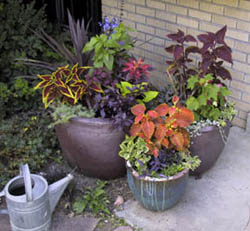 |
Many Coleus leaf forms and colors add interest and unite the multiple containers in this planting. (Photo by C. Wilson.) |
Container gardens require more frequent watering than “in-ground” landscapes because the exposed sides of the containers result in more evaporation. Plastic containers do not dry out as quickly as ceramic, especially unglazed ceramic pots. Even plastic containers may require daily or twice daily watering as plants grow larger. Do not allow containers to dry completely or fine roots will die. Also, if allowed to dry excessively, the potting media will shrink away from the side of the container and be harder to re-wet.
There are water holding polymers or gels that are available for purchase or are included in some potting soils. These polymers do hold water as promised, but research has shown that the amount of water available to the plant is not enough to prolong periods between watering here in Colorado. Adding too much of the polymer can cause the soil to retain too much water and soil may spill from the pot.. There are also new self-watering pot systems that may potentially reduce watering maintenance.
Most municipal water systems on the Front Range are from mountain sources which are excellent and cause few problems. However, water from wells and much of the Western Slope is often high in salts or carbonates which can cause some problems. One way to prevent excessive salt buildup is to water completely where 10 percent of what is added drains out the bottom. This will help reduce the salt build-up that is damaging to plants, causing burned leaf edges, stunted growth, and fewer blooms. If saucers are used to catch drained water, empty them to prevent salt buildup. This can be done easily with a kitchen baster; however, dedicate one to the garden and don’t reuse it in the kitchen.
Water is often used to carry soluble fertilizers to the roots of container plants. Fertilizers are forms of salts, so salt management is important because of the need to fertilize container plants regularly.
Fertilizing
The rapid growth of many container plants quickly depletes the fertilizer available in the limited volume of soil. Well-drained soil mixes also result in the regular loss of fertilizer in the drainage water.
To provide the right amount of fertilizer, mix controlled-release fertilizer granules into the soil mix at planting. The large number of plants often grown in containers places extra demands on the fertilizer supplied by timed-release products. Under Colorado conditions, the fertilizer supplied by these products is generally insufficient to carry container plants through the growing season. Therefore it is necessary to use fully soluble fertilizer products added to the irrigation water to supplement or replace timed-release products. Organic fertilizers such as fish emulsion or blood meal can also be used if desired, but may be available too slowly for actively growing plants, or may develop sour aromas that attract pets and pests.
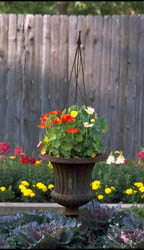 |
As a general guide, flowering plants, water plants, and fruiting vegetables require a minimum of eight hours of full sun each day to perform well. Root vegetables do best with six hours, and leafy vegetables and many herbs should receive at least four hours of sun. Some foliage plants are best located in filtered light or continuous shade.
Dilute soluble fertilizers may be used with every watering, or at full strength on a weekly or every two-week basis, depending on the type of plants being grown. Follow product directions for concentrations and timing.
Light
It is critical to supply the right amount of light based on the plant’s need. Follow the individualized requirements found on plant labels or in references, and don’t mix plants with different light needs.
Consider the light available in the location where containers are to be placed when initially selecting plants. Note that the portability of containers allows for moving them to different locations if plant growth falters because of too much, or too little, available light. Shifting container locations is also desirable as the amount of available sunlight changes with the seasons.
Reflected sunlight can be damaging to plants as well. Western exposures may provide a risk for sun scald on many plants and this may be increased with reflected light off lightly colored buildings and paving.
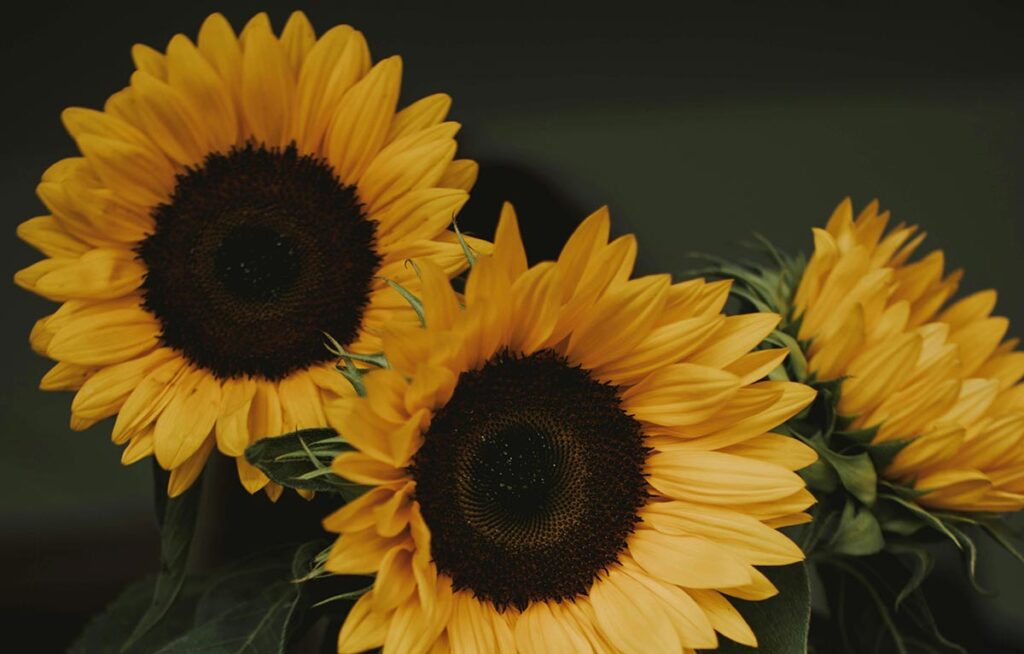
Design Basics
There are a few design principles to consider when planting container gardens. They concern dimension, shape, and color.
To avoid a flat look, add a spike, a tall plant, or a garden ornament for height and a trailing plant to drape down from the container. Chose plants that are in scale with the size of your container and planting backdrop. As a guideline, plants should be twice as tall as the visible part of the container. If planting one large plant such as an ornamental grass, select a larger container that will fulfill both plant growth and design needs. Large plants can overwhelm small situations and small plants make little impact in large spaces. A grouping of different sized containers will also help achieve this goal. Also consider whether the container will be viewed from one side or several angles and position plants accordingly.
Consider the texture or shapes of plant leaves and flowers. A variety of leaf shapes and sizes can be more appealing than uniform foliage. Combine round-shaped flowers with irregularly shaped ones.
Color Wheel
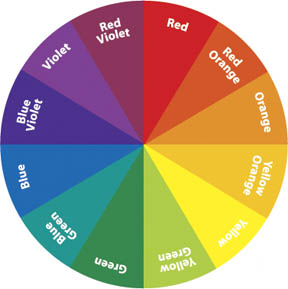 |
Figure 1. While combining flower colors is a personal choice, there are design principles to keep in mind. Use complementary colors on the opposite side of the color wheel or analogous colors adjacent on the color wheel. Examples of complementary colors are orange and blue or yellow and violet. Analogous color examples are orange and yellow, or blue and violet. |
Container gardening can add impact to your garden or outdoor room through the use of color. Hot colors, like orange and red, stand out; while cool colors like blue and violet recede in to the space. One-color compositions can be used but may look flat. Repeating a flower color among the different vertical plant layers will give a stronger and more unified appearance.
A grouping of containers devoted to different colors can help achieve the composition desired. Consider the color of plants within a container and the color among the group of containers. The colors of the containers themselves will contribute to the entire effect.
Take advantage of the variety of foliage colors. Foliage can be silver, gray, red, many shades of green, including yellow-green and blue-green, and the tawny beige found in winter dormant grasses. Variegated foliage can be the perfect complement to complete a colorful container.
Finally, use your imagination and find what pleases you. Remember that you can easily rearrange and replace plants within a container as well as rearrange which containers are grouped together.
Plant Possibilities
Choose plants based on light, moisture, color, height, shape, texture, desired theme, and more.
The group of plants most immediately thought of for container use may be annuals. In addition to new versions of old favorites, many new choices are available. Geraniums feature new zonal, ivy, and cascading types. New petunia colors are available as well as improved trailing types that require no pinching or pruning. There is also a mini-trailing petunia family species, Calibrachoa, with quarter sized blooms. Other improvements have been seen in Verbena, Salvia, Impatiens, and Fuchsia. Among the relatively new annuals are Angelonia, Bacopa, Ipomea, Evolvulus, Bracteantha, Pentas, Scaevola, and Torenia.
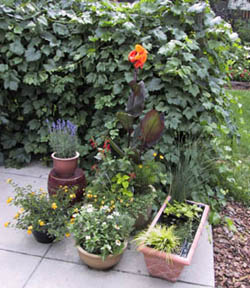 |
A grouping of containers of different heights includes a rectangular container water garden on the right. (Photo by C. Wilson.) |
Don’t overlook “indoor” or tropical foliage plants for shady areas. Consider Dracaena, Schefflera, Ficus, Aspidistra, and Fatshedera. Another group of sun-loving plants is cacti and succulents, but don’t combine them with plants that require more moisture.
Perennials can be combined with annuals to achieve design goals. Burgundy leaf Eupatorium ‘Chocolate’ will contribute bold foliage color as will the red and rainbow colored leaves of Canna and Caladium varieties. For irregular-shaped flowers, try Agastache, Gaura or the more herbaceous-type Penstemon. Agastache adds the bonus of attractive fragrances to container gardens. Perennials are generally treated as annuals in containers and not overwintered.
Bulbs and bulb-like plants can also be grown in containers. Consider Asiatic and Oriental lilies, dwarf dahlias, gladiolus, Montbretia (Crocosmia), Calla lilies, Anemones, tuberous begonias, and Siberian iris.
Ornamental grasses and grass-like plants grown in containers make bold statements. Pennisetum, Miscanthus, Calamogrostis, Deschampsia, Panicum, and for very large containers, Phyllostachys may be considered.
Either alone or as the tall plant featured in a mixed container, consider woody plants. Interesting single plant specimen choices are Cytisus, Caryopteris and the dwarf conifers like Dwarf Alberta spruce, Little Gem Norway spruce, and Blue Shag dwarf white pine. For a Japanese garden look consider Japanese maple or Nandina. If you’re looking for red foliage, think Newport plum.
If you want to evoke an English cottage garden, container roses make a good choice. The bright blooms of Osteospermum, Hibiscus, and Lantana will create a tropical feeling.
Vines on a trellis can also be used in container gardens. Consider morning glory, Nasturtium, scarlet runner bean, or canary creeper. Or tropical vines such as Mandevilla or Bougainvillea.
Many vegetables can be successfully grown in containers. Look for varieties that are labeled as “bush,” “patio,” “dwarf,” or “compact.” Often variety names imply compact such as ‘Patio’ or ‘Tiny Tim’ tomatoes, ‘Spacemaster’ cucumber, ‘Morden Midget’ eggplant, ‘Short & Sweet’ or ‘Thumbelina’ carrots. These are prolific producers that require minimal space. Read the label for overall plant size. Vegetables suitable for containers include beets, beans, cabbage, carrots, cucumber, eggplant, green onions, lettuce, collards, bok choy, spinach, kale, tomatoes, peppers, and radishes.
Among the herbs suitable for containers are thyme, oregano, parsley, rosemary, basil, chives, cilantro, and lavender. Herbs add foliage texture and color, plus they may be edible or contribute fragrance to the landscape or ornamental containers.
Container Maintenance
Many new annual flowers do not require deadheading to bloom over a long period. Some removal of spent flowers is desirable with many perennial flowers to prolong bloom. Regular harvest of herb leaves and vegetable fruits will also prolong the useful life of these plants.
Stake or cage larger vegetable plants such as tomatoes and flowers such as sunflowers. Vining plants such as cucumbers and morning glories will require support from a trellis or cage.
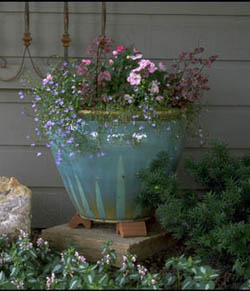 |
It is difficult to overwinter plants outside in a container. The roots will desiccate without moisture thus winter watering and protection are necessary. Protection for containers containing woody or herbaceous perennial species may include heavy mulching or burying the container in the ground. Many containers, especially porous ones, will crack if the moist media is allowed to freeze and thaw throughout the winter.
Treat perennials, ornamental grasses, and woody plants as annuals, and don’t plan to overwinter them outdoors in the original container without consideration for typical Colorado freeze and thaw cycles. You may transplant non-annuals into the garden at the end of the season. Otherwise, you can move containers with perennials, ornamental grasses and woody plants to an unheated garage or storage shed. In an unheated indoor location, please be sure and provide water monthly to the container.
All media and plants can be discarded into the compost pile at the end of the growing season, with the exception of diseased plants. They need to be disposed of separately so that disease does not spread. Disinfect containers by scrubbing with a 10 percent solution of chlorine bleach to kill any organisms that remain on the container.
Water Plants: What to Know
In addition to plants that grow in soil, consider aquatic plants for container gardens. Container water gardens use water instead of soil mixes to support plant life. Some plants float such as water lettuce, Pistia stratiotes and water hyacinth, Eichhornia crassipes. The plants that grow at the water’s edge, “marginals,” are potted in a heavy clay soil in mesh pots. The pots are supported on a pedestal of rocks or bricks to position the top of the soil at the water line within the container.
Though containers can be small and hold one plant, a medium-sized container allows for growing a number of plants. With a container 12 to 24 inches wide and 12 to 16 inches deep, use the same design rules employed in combining land plants. Select a spiky, erect, plant such as sweet-flag, Acorus calamus, or yellow flag iris, Iris pseudacorus. Combine with a broad-leaf plant such as giant arrowhead, Sagittaria latifolia, or calla lily, Zantedeschia aethiopica. Add a cascading plant such as water mint, Mentha aquatica, or parrot feather, Myriophyllum aquaticum. Finish the planting with floating plants such as those mentioned earlier. Two to three potted plants and some floating ones make quite an impact.
Place the container where it will receive six hours of sun each day. Add water every few days as it evaporates. When plants begin to grow, add a fertilizer tablet available at the garden center where the plants were purchased. If algae or mosquito larvae develop, mosquito dunks and algicides are available to safely combat the problem. Both products are safe for people, pets, and birds. They can be found at most gardening and big box stores.
Container water gardens may either be treated as annuals or brought indoors for the winter if a sunny location is available. Plants will require the same six hours of sun that they do outdoors. As with annuals brought in for the winter, be mindful of bringing spider mites and insect pests indoors with your water plants. Examine and treat plants for pests before moving. Indoors, a small, submersible aquarium or indoor fountain pump is useful for aerating the water to keep it fresh. Add water as needed through the winter. In spring, divide the plants that have grown too large and replant the container outdoors for the summer.
An increasing number of water plant choices are available at major garden centers. Container water gardens are actually quite simple and worth trying.
*M. Roll, Colorado State University Extension horticulture agent, Arapahoe County; and C.R. Wilson, horticulture agent, Denver County. **Revised by L. Greene, Colorado State University Extension Horticulture Assistant, Arapahoe County. 11/02. Revised 8/20.
Colorado State University, U.S. Department of Agriculture and Colorado counties cooperating. Extension programs are available to all without discrimination. No endorsement of products mentioned is intended nor is criticism implied of products not mentioned.
Go to top of this page.





